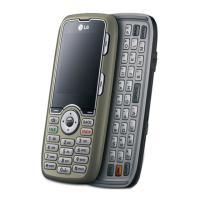
 Loading...
Loading...
Do you have a question about the LG LG260 and is the answer not in the manual?
| EDGE | No |
|---|---|
| SIM | Mini-SIM |
| Status | Discontinued |
| Display type | TFT, 256K colors |
| Loudspeaker | Yes |
| 3.5mm jack | No |
| Radio | No |
| Games | Yes |
| Talk time | Up to 3 h |
| Display size | 2.0 inches |
| Display resolution | 176 x 220 pixels (~141 ppi density) |
| Alert types | Vibration; Downloadable polyphonic ringtones |
| USB | Yes |
| Messaging | SMS, MMS |
| Java | Yes |
| Battery | Removable Li-Ion battery |
| Colors | Black |
Guide to unlocking your phone, setting up voicemail, establishing passwords, and contacting customer care.
Instructions for setting up your voicemail, including passcode, name announcement, and greeting.
Information on accessing Directory Assistance and Operator Services for phone support.
Covers fundamental functions: front view, display screen, features, power, battery, menus, calls, and text entry.
Diagram and explanation of the phone's physical buttons and components.
Explanation of status icons and symbols displayed on the phone's screen.
Highlights major features like dual-band, data service, voicemail, messaging, QWERTY keyboard, games, and camera.
Instructions on how to turn the phone on and off, including power save features.
Information on battery capacity, charging, installation, removal, and charger usage.
Guide to using the navigation key and softkeys to move through menus and select options.
Step-by-step guide on how to initiate, receive, and end phone calls.
Instructions for typing text using the alphanumeric keypad and QWERTY keyboard, including T9 input.
How to customize ringer types for calls and messages, and key tone volumes.
Options for changing text greeting, backlight time, display image, menu style, and clock appearance.
Enabling or disabling the phone's location feature for location-based services.
Settings for message notification, reminders, callback numbers, and deleting old messages.
How to enable Airplane/Music mode to use features where calls are prohibited.
Information on using the phone with TTY devices for telecommunication.
Customizing navigation key shortcuts and setting call answer modes.
Steps to access the security menu by entering the lock code.
Instructions for locking the phone for security and unlocking it with the lock code.
Adding and managing special numbers that are always available, even when the phone is locked.
How to quickly and easily erase all entries from the phone's Contacts List.
Limiting the numbers your phone can call, including restricting outgoing calls or data access.
Steps to erase cache, cookies, history, and bookmarks from internet usage.
Procedure to reset all phone settings and erase all data, restoring it to factory defaults.
Information on recognizing the roaming icon and how roaming works on digital and analog networks.
Options to control roaming capabilities: Automatic, Home Only, or Roaming Only.
Alerts for roaming calls and managing roaming charges by requiring an extra step.
Enabling Data Roam Guard to control internet access in data roaming areas.
How to view lists of placed, accepted, and missed calls, with details like number and name.
Options available for a selected call entry: dial, save, send message, delete, next, or previous.
Steps to place a call directly from the Call History list.
How to save a phone number from Call History into your Contacts list.
Procedure to erase individual call entries or the entire call history.
Steps to add a new person's name, phone number, and other details to your Contacts.
Methods to find contacts by name, speed dial number, or group.
Options for editing contact details like name, number, email, group, and ringer.
Steps to modify or correct a phone number associated with a contact.
How to assign speed dial numbers to contact entries for quick dialing.
Viewing, editing, and sending personal contact information (vCard) via Bluetooth.
Making changes to existing contact information such as name, group, or ringers.
Assigning a specific ringtone to a contact entry for caller identification.
Organizing time and events by adding, viewing, and managing calendar entries.
Setting and managing multiple alarms with customizable times, repeat options, and ringers.
Composing, saving, reading, and deleting notes and reminders.
Accessing tools like EZ Tip Calculator, Calculator, World Clock, D-Day Counter, and Unit Converter.
Recording, playing, editing, and deleting voice memos and conversations.
Inserting, removing, and handling the microSD card and its adapter.
Creating folders, viewing memory status, and formatting the microSD card.
Steps for connecting the phone to a computer for data transfer via USB.
Instructions on how to activate camera mode and capture photos.
Steps to record, view, and send videos using the phone's video camera.
Information on storage options: In Phone folder, Memory Card, and Online Albums.
How to send captured pictures and videos to contacts via messaging.
Instructions on how to enable or disable the phone's Bluetooth functionality.
Configuring Bluetooth name, visibility, and device information.
Process for establishing trusted connections by pairing the phone with other Bluetooth devices.
Overview of essential calling features: voicemail, SMS, caller ID, call waiting, and three-way calling.
Setting up, receiving, and retrieving voicemail messages.
Composing, sending, reading, and replying to text messages.
Identifying callers and blocking your number from being displayed for outgoing calls.
Handling incoming calls while already on a call, switching between callers.
Instructions for conducting a conversation with three people simultaneously.
Forwarding incoming calls to another phone number when the phone is off or unavailable.
Overview of applications like Games, Ringers, Screen Savers, and Web access.
Basics of data service: user name, launching connections, and navigating the Web.
How to download games, ringers, screen savers, and applications from the phone.
Browsing websites, accessing categories, and using browser menus and functions.
Answers to common questions about data connection status, usage, and sign-out.
Managing music content on a computer and transferring it to the phone's microSD card.
Using the Media Player to play music files saved on the microSD card.
Crucial operational and safety guidelines to ensure safe phone usage and prevent injury.
Guidelines for proper phone operation, antenna handling, and avoiding damage or hazards.
Warnings about emergency calls, driving, electronic device interference, and dangerous areas.
Information on hearing aid compatibility and potential interference issues.
Guidelines for protecting battery performance, safe charging, and proper disposal.
Explanation of how the phone operates with RF signals and safety standards.
Details on what the limited warranty covers, does not cover, and how to obtain service.